Similar Posts
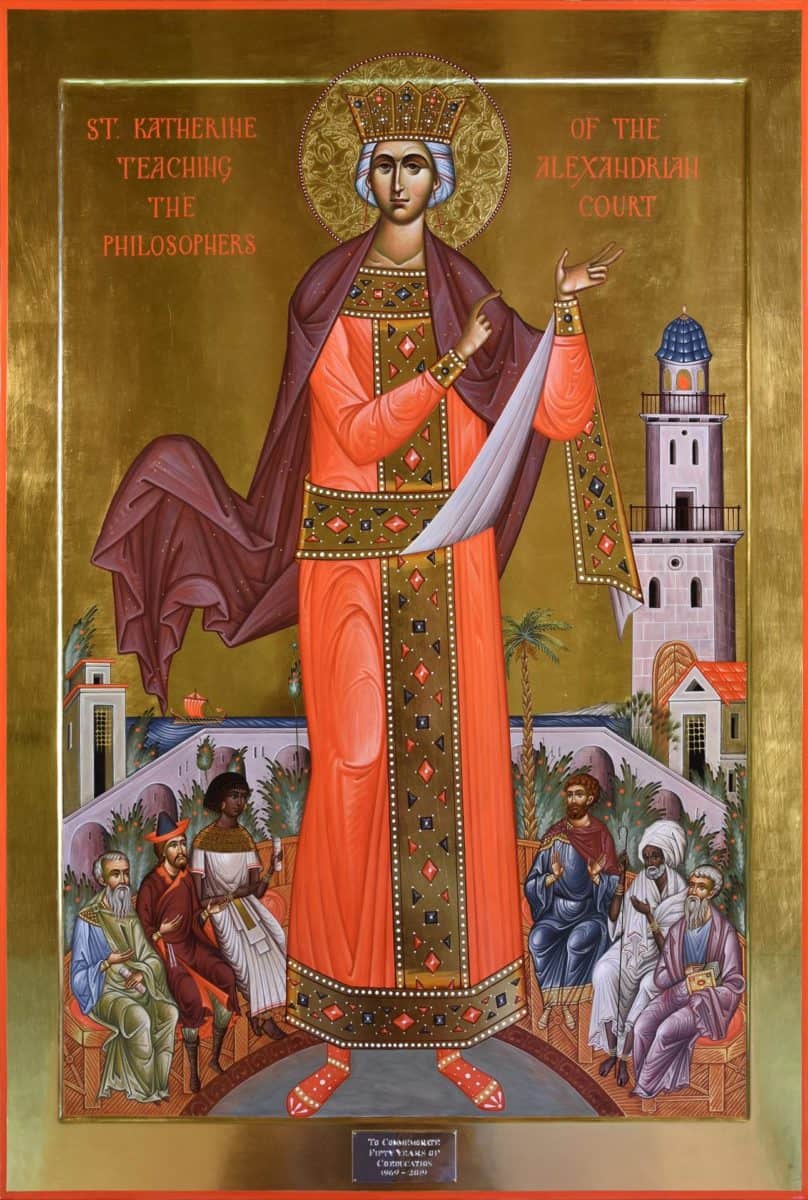
Saint Katherine Teaching the Philosophers of the Alexandrian Court, painted by Natalia Aglitskaya, 2019.
I would like to share an interesting project in which I collaborated with iconographer Natalia Aglitskaya to develop a new icon composition. The project was a commission from Trinity College in Hartford, Connecticut, to commemorate their fiftieth anniversary of coeducation, which occurred in 2019. The college wanted a memorial to the admission of women to be installed in the chapel. The chaplain approached me with the idea of creating a special icon depicting Saint Katherine of Alexandria, who stands out among women saints for her reputation as a scholar.
Trinity College Chapel is an important work of Neo-Gothic architecture built in 1933. It was designed by Philip H. Frohman, architect of the National Cathedral, and is consecrated as an Episcopal church. I have had the opportunity to furnish custom light fixtures for the chapel on several occasions, and was pleased to accept the commission to create a memorial icon. A large gilded icon would look impressive in the stony colorless interior of the chapel, and would expose the tradition of Orthodox liturgical art to the students of many faiths who use the chapel.
I ordered a custom handmade board from Saint John’s Workshop, and hired Natalia Aglitskaya to paint the icon. Natasha paints in a rich classic Russian style, and she has internalized the tradition such that she can draw original compositions with great authenticity.
In designing the image, the first challenge was the rare subject. According to the hagiography of Saint Katherine, she was the aristocratic daughter of the Roman governor of Alexandria. As a wealthy girl living in the famous city of libraries and scholars, she received a world-class education. After her conversion, she decided to confront Emperor Maximian (A.D. 305-313) and implore him to stop persecuting Christians. The emperor, intrigued by her beauty and intellect, assembled fifty renowned scholars and challenged them to convince her of the superiority of paganism. Katherine won the debate, and the philosophers accepted Christ, resulting in all of them being martyred.
Though the debate with the philosophers is central to St. Katherine’s story, it is very rarely depicted. We were able to find a few western paintings of this scene, but no historic Orthodox icons. It was not obvious how to compose one, as crowd scenes in icons can take several forms. Ultimately, we decided that Katherine needed to be far more prominent than the other figures. She needed to fill the board if the icon was to serve as a devotional image, rather than a merely illustrative one. So we placed the saint on a central stage, with the philosophers gathered on benches in the background. The non-linear perspective of icons allows this to work quite well.
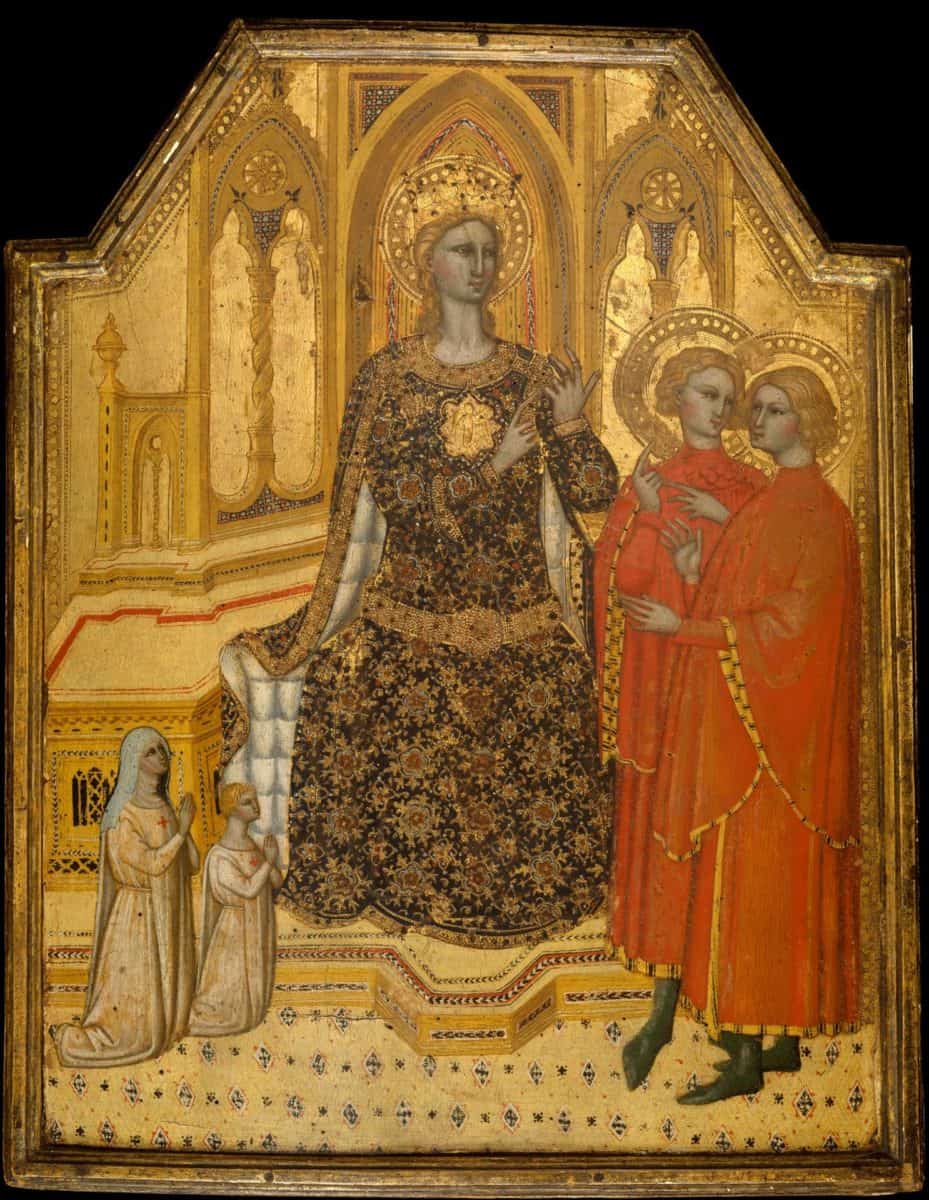
A western icon, circa 1380, showing Saint Katherine disputing the philosophers. By Cenni di Francesco.
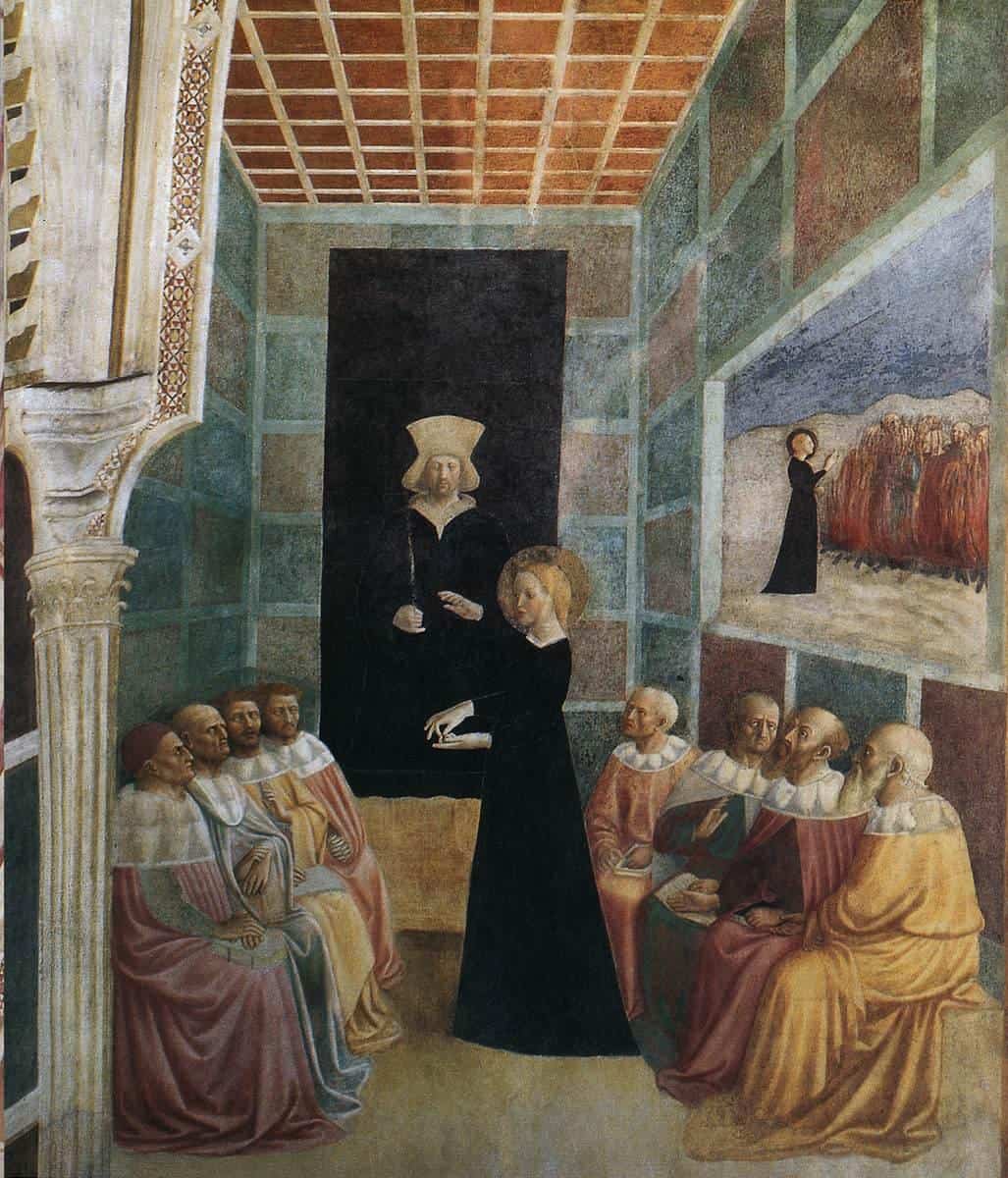
A Renaissance fresco depicting the same subject, in the Basilica of St. Clement in Rome. By Masalino da Panicale, Circa 1425.
A second challenge was a requirement from the College Administration – the icon had to depict ethnic diversity, including both black and Asian figures. This, of course, is not typical in icons, and pagan philosophers would normally be depicted as Greeks in togas (one of the few cases in icons where such dress would actually be historically accurate!). I did not want merely to include token ethnic people in togas, so I considered how to make this requirement an asset to the project. Alexandria was a major capital of the Roman Empire and the world’s center of learning, so it seems plausible that scholars from the wider world could have been present at the emperor’s court. So I asked Natasha to include a figure from Ethiopia, another from Nubia, and finally a Hun (the Huns bordered the Roman Empire at that time, and had Asiatic features). I researched the historical dress of these nations, and provided reference images to Natasha, which she translated into iconic figures.
Additionally, I was eager to make the contextual scenery in the icon recognizable as Alexandria. I asked Natasha to place the harbor in the background, so that the emperor’s court would overlook the sea. In those days, Alexandria had the most famous harbor in the world, thanks to the Pharos, the great lighthouse, one of the Seven Wonders of the World. This lighthouse stood from the 3rd century B.C. until the 14th century AD, and was the defining monument of the city. Its appearance is well known from ancient descriptions and mosaic images, and I helped Natasha design an accurate rendition of it in icon-style. We also studied the flora of Alexandria and made a point of including a date palm and papyrus. I feel these details will be of great interest to those who are learned in history and geography, and will help to make the icon accessible to the many non-Christians at the college.

A mosaic from San Marco, Venice depicting the Pharos. This mosaic was made when the lighthouse still stood. Above is a modern reconstruction of the design.
I wanted the subject of this icon to be understandable to people unfamiliar with the life of St. Katherine, and unfamiliar with icons and hagiographic titles in general. So I decided to title the icon with a clear and descriptive text: Saint Katherine Teaching the Philosophers of the Alexandrian Court. It is not very typical of an icon inscription, but it is grand and mysterious, and I hope it intrigues people and encourages them to look up the whole story.
The style of lettering is always tricky in English-language inscriptions. I don’t care for fonts which try to disguise our alphabet as Greek or Slavonic, but a completely western font can be visually discordant with the Orthodox style of painting. Furthermore, fonts that are too easy to read can be a distraction from prayer, as the eyes are drawn to keep reading the words again and again. But a font that is too illegible would not work here either. Ultimately, I designed my own icon font with influences from Edwardian typography and Romanesque inscriptions. I hope it will prove helpful to other iconographers struggling with how to depict the western alphabet in icons.
The icon required a dedicatory inscription as well, referencing the anniversary of coeducation, but I did not want this inscription painted in as though it were part of the icon. Instead, I hired a silversmith to make an engraved plaque for the bottom edge of the frame. This allows the dedicatory inscription to visually stand apart from the painted holy image. I also provided one my simple glass lampadas, and a custom wrought iron hook with which to hang it from the stone wall.
I pray that this new icon composition will prove edifying to the church, and that others may see fit to paint this interesting subject from the life of St. Katherine.
If you enjoyed this article, please donate to support the work of the Orthodox Arts Journal. The costs to maintain the website are considerable.


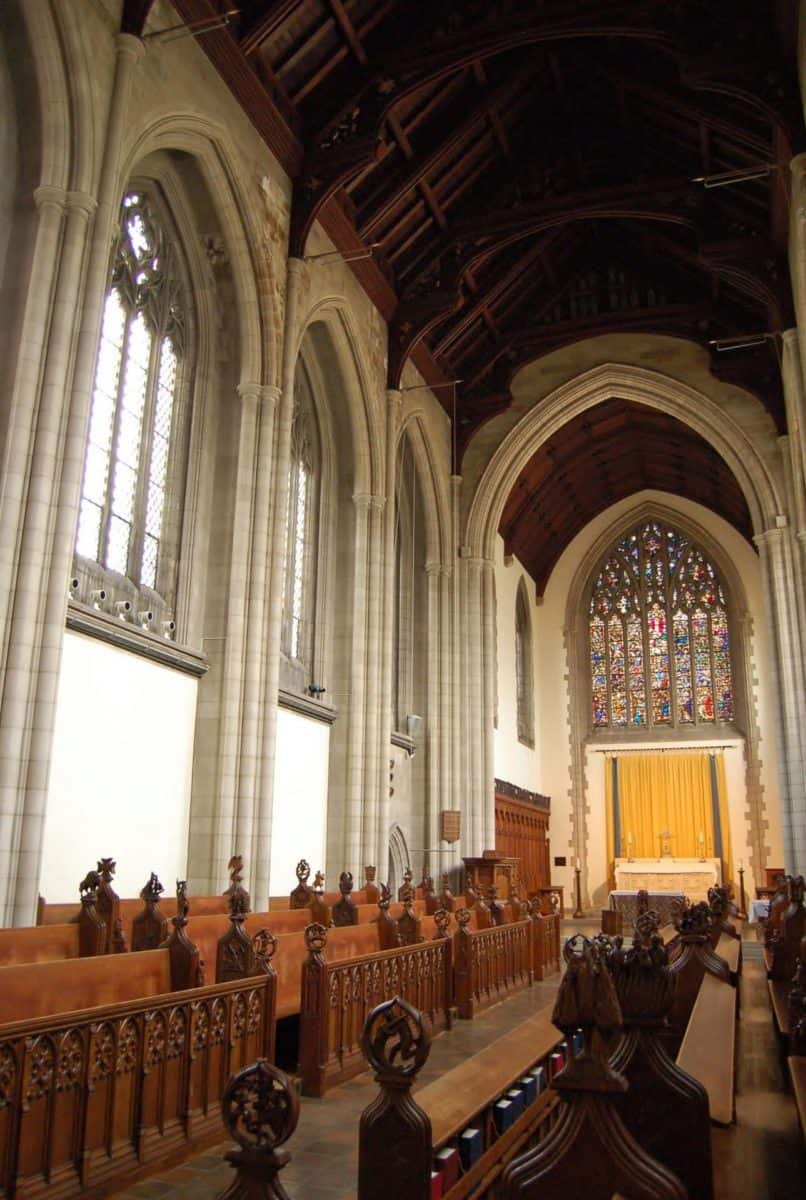
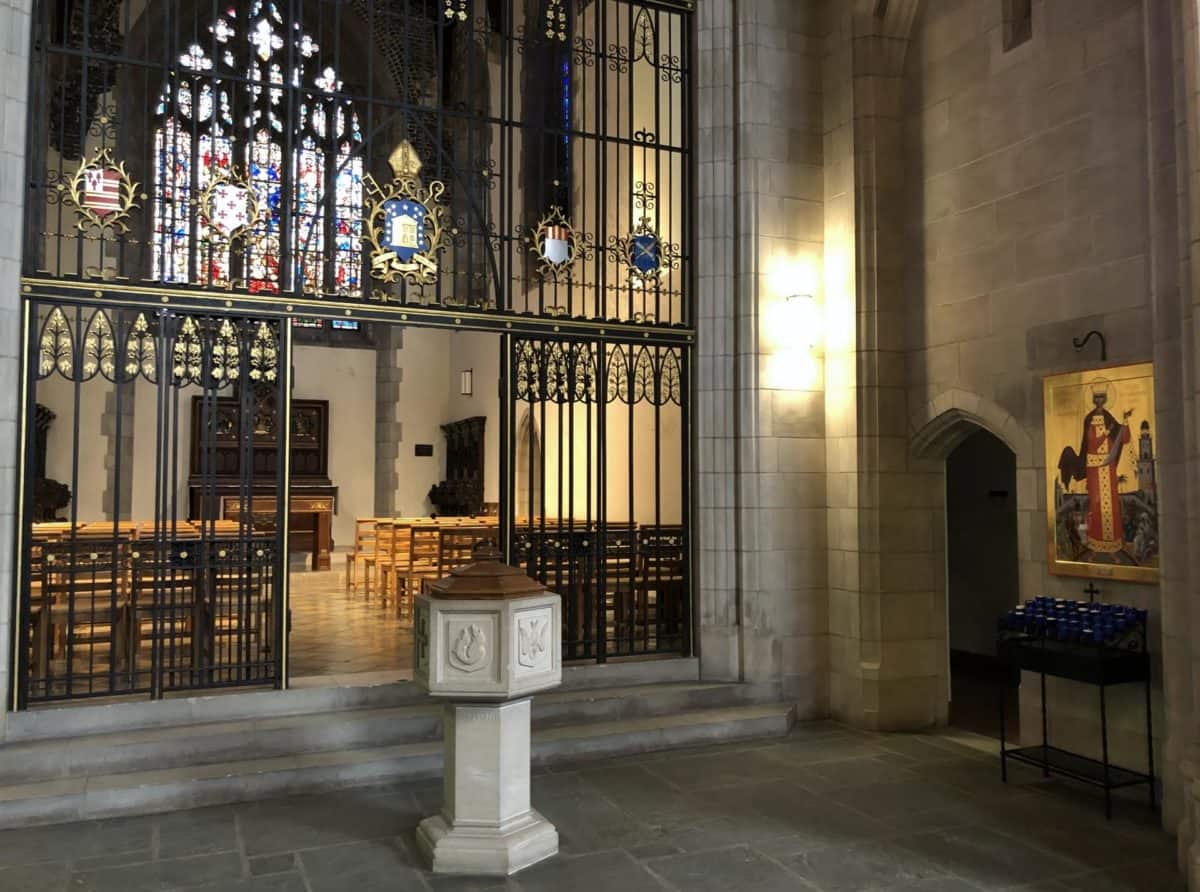
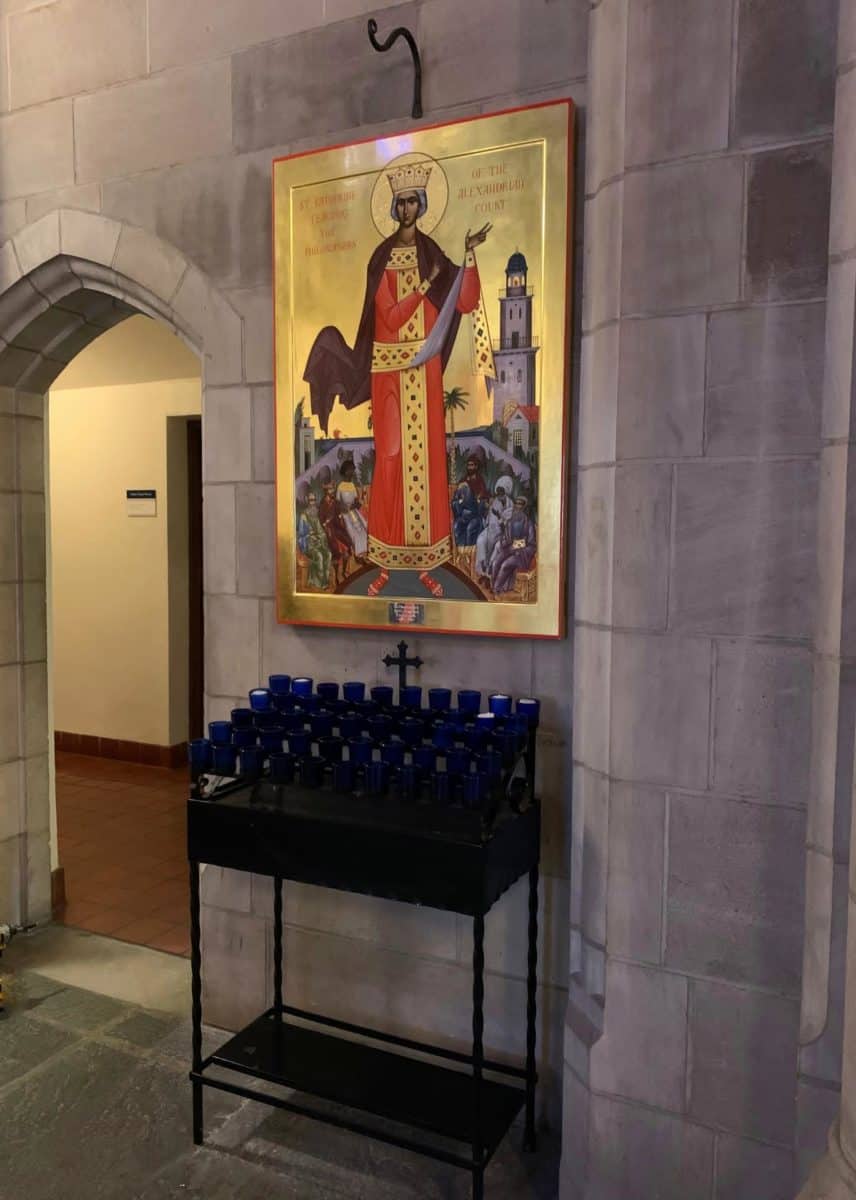
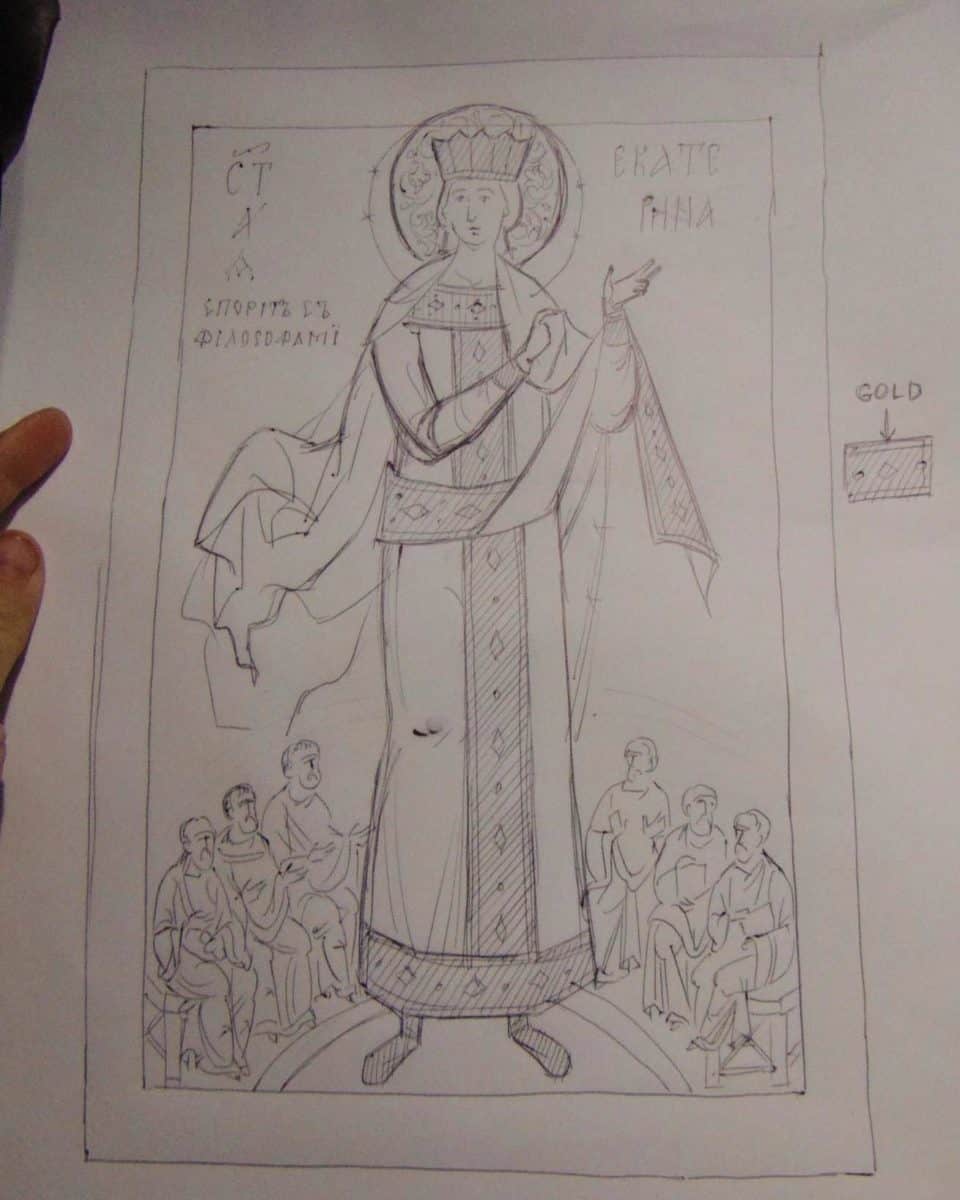
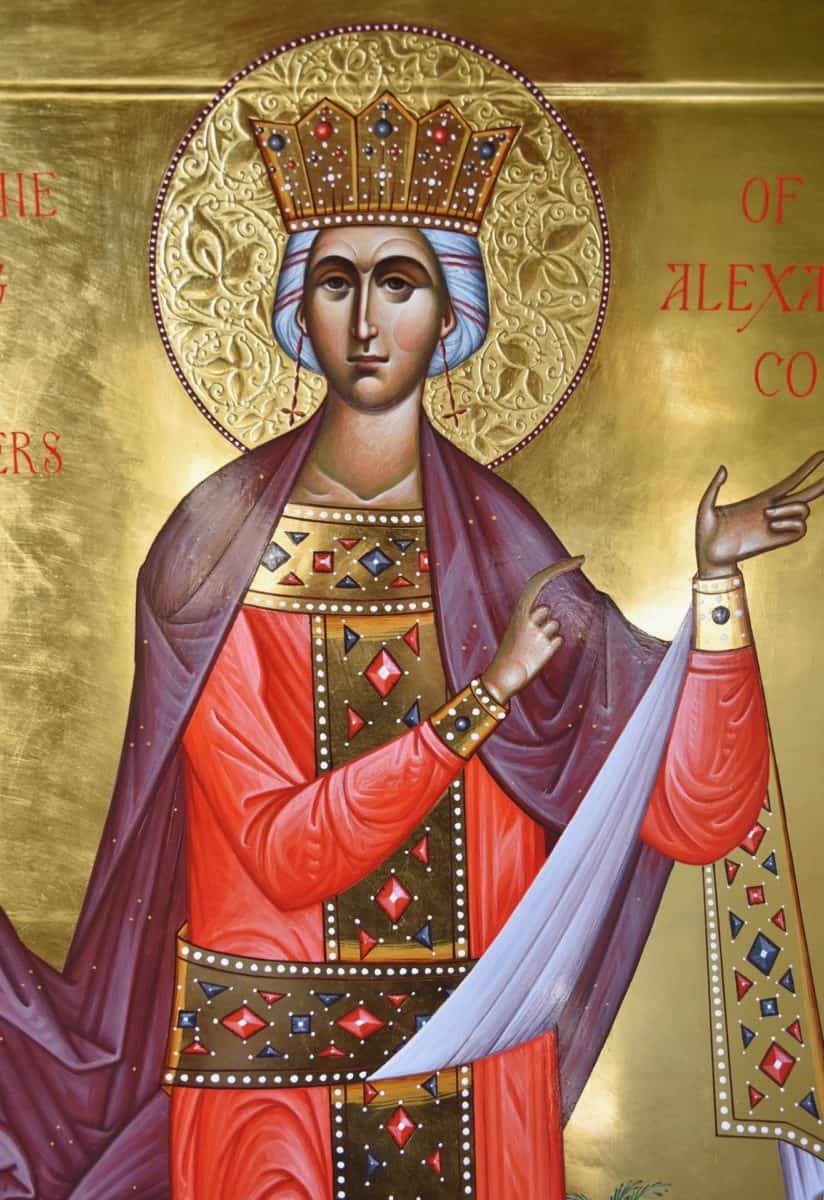
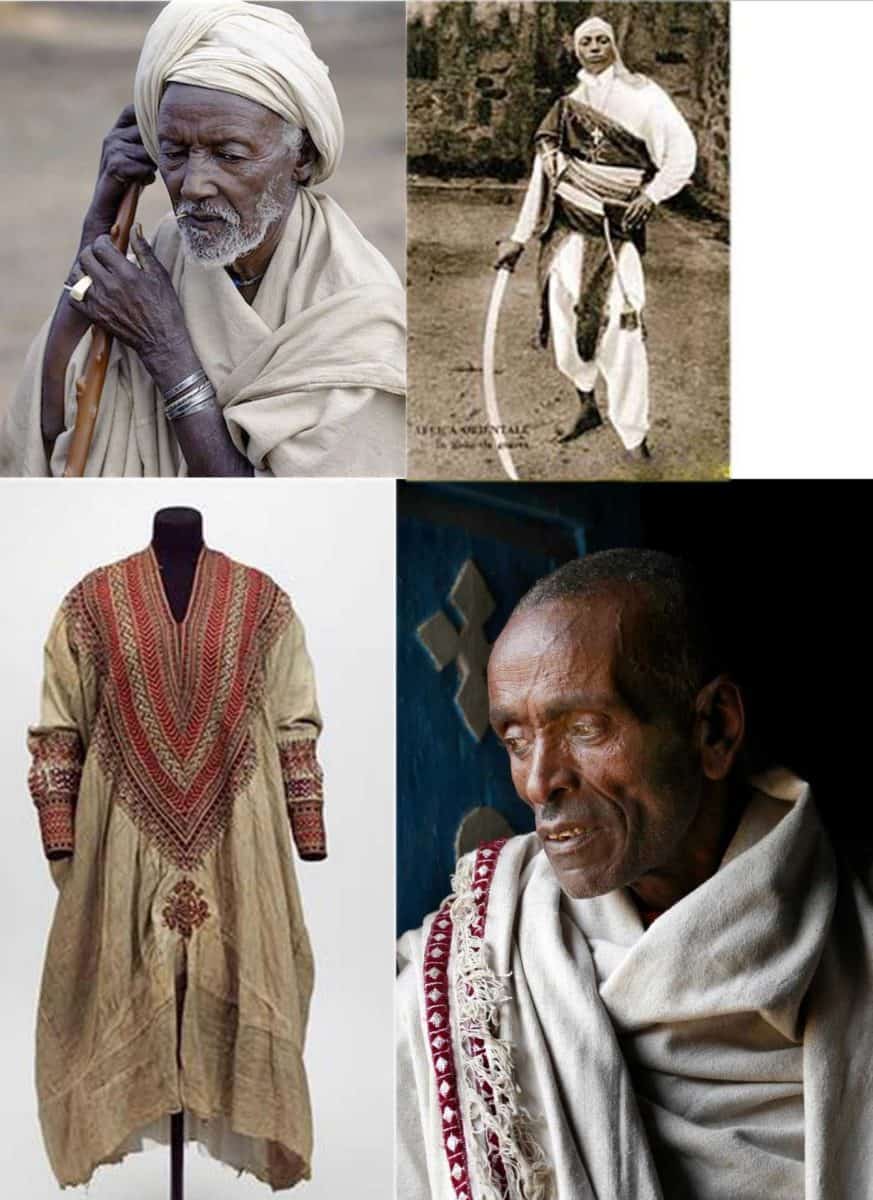
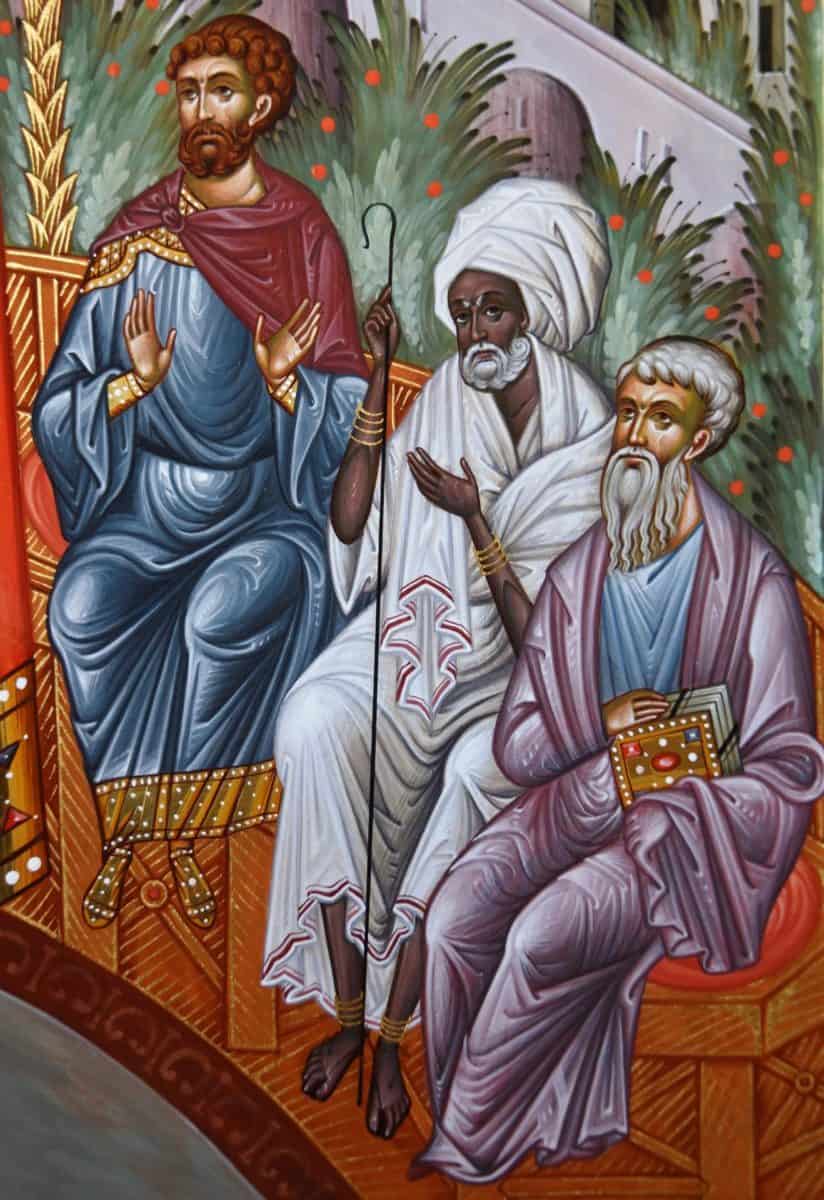
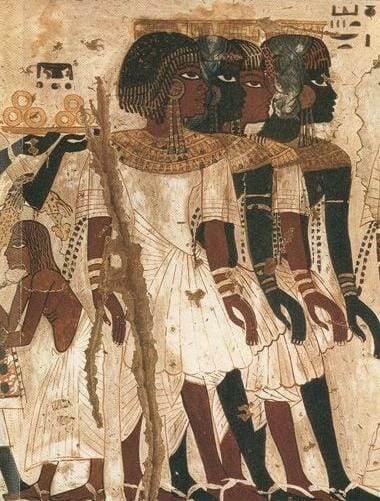

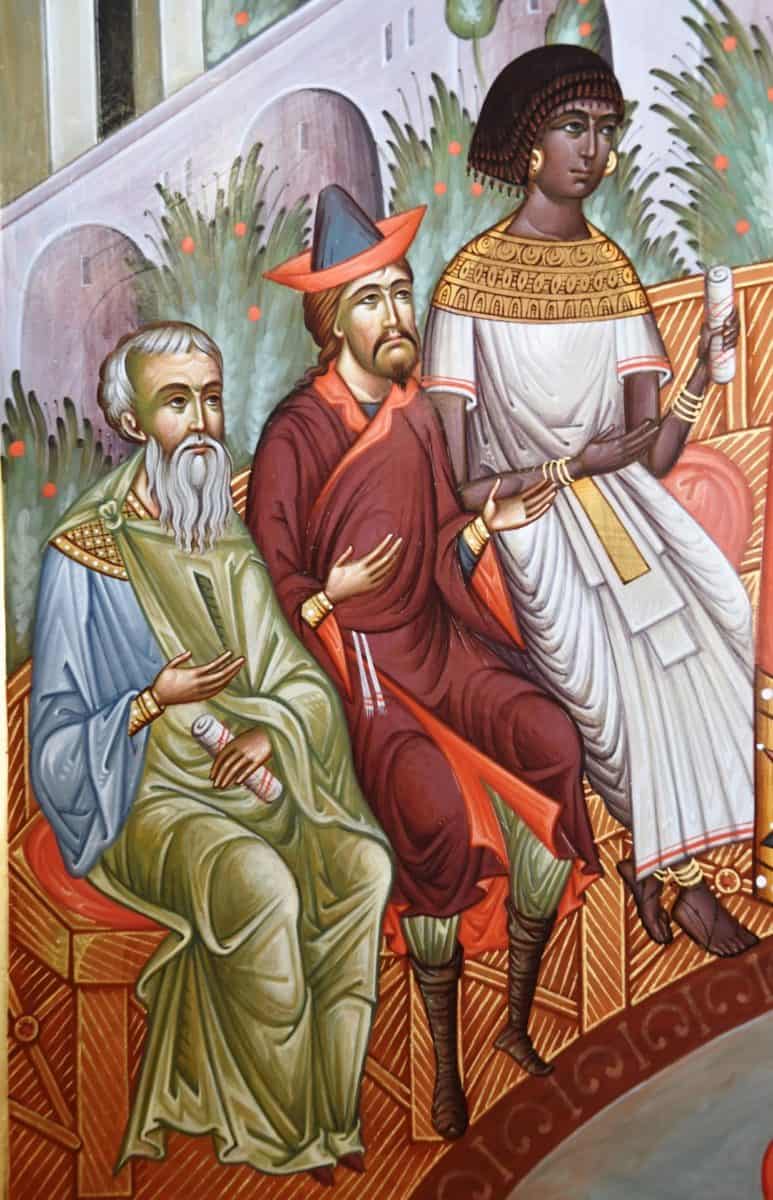
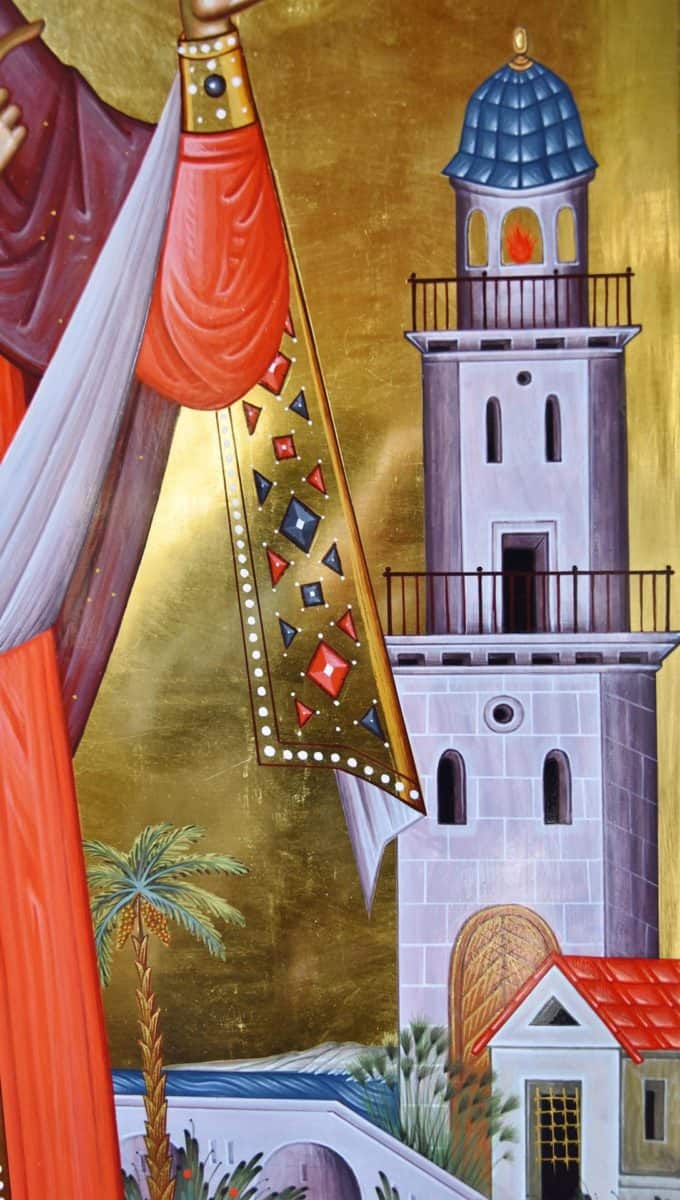
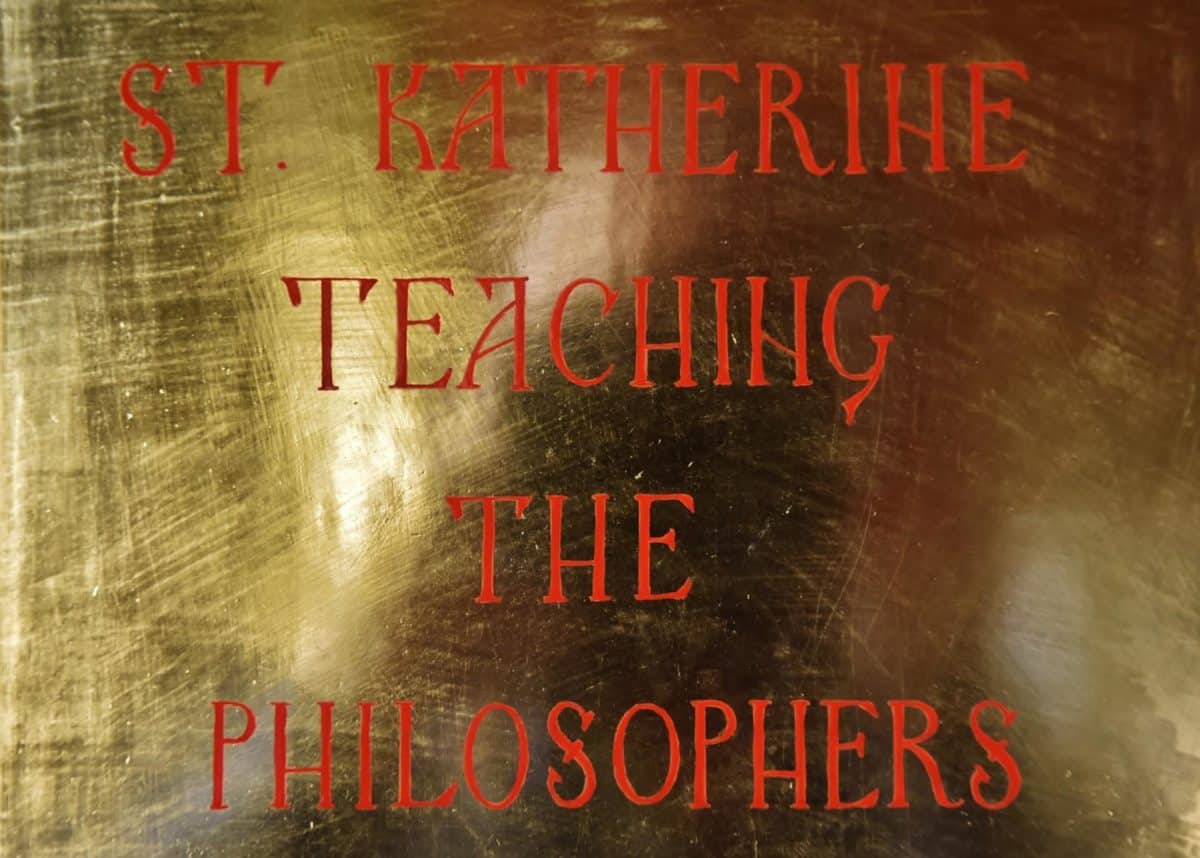
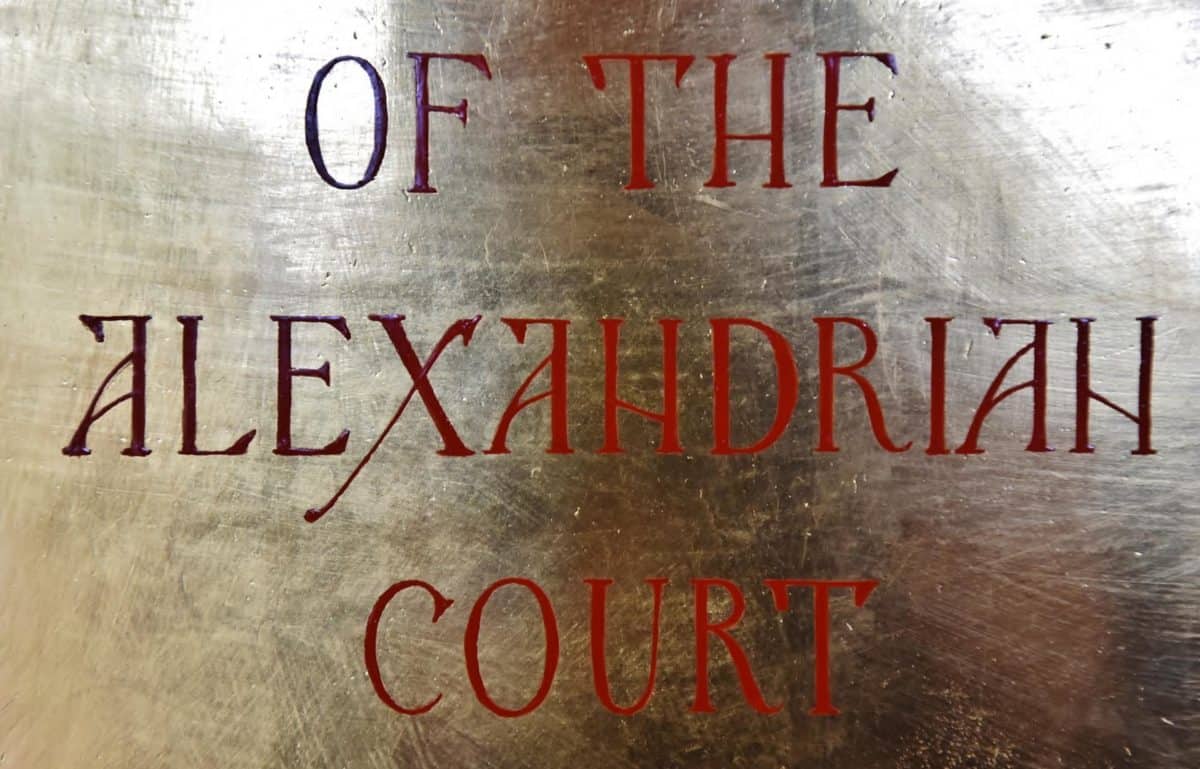
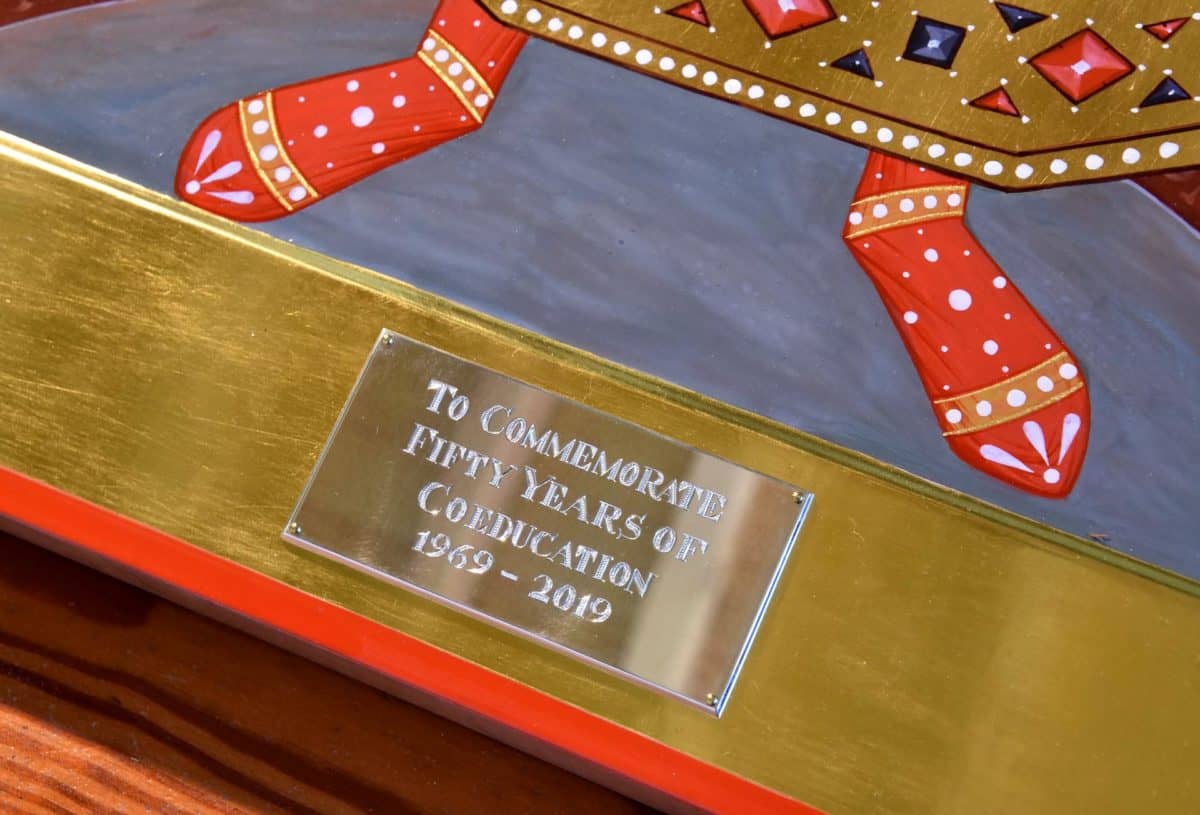
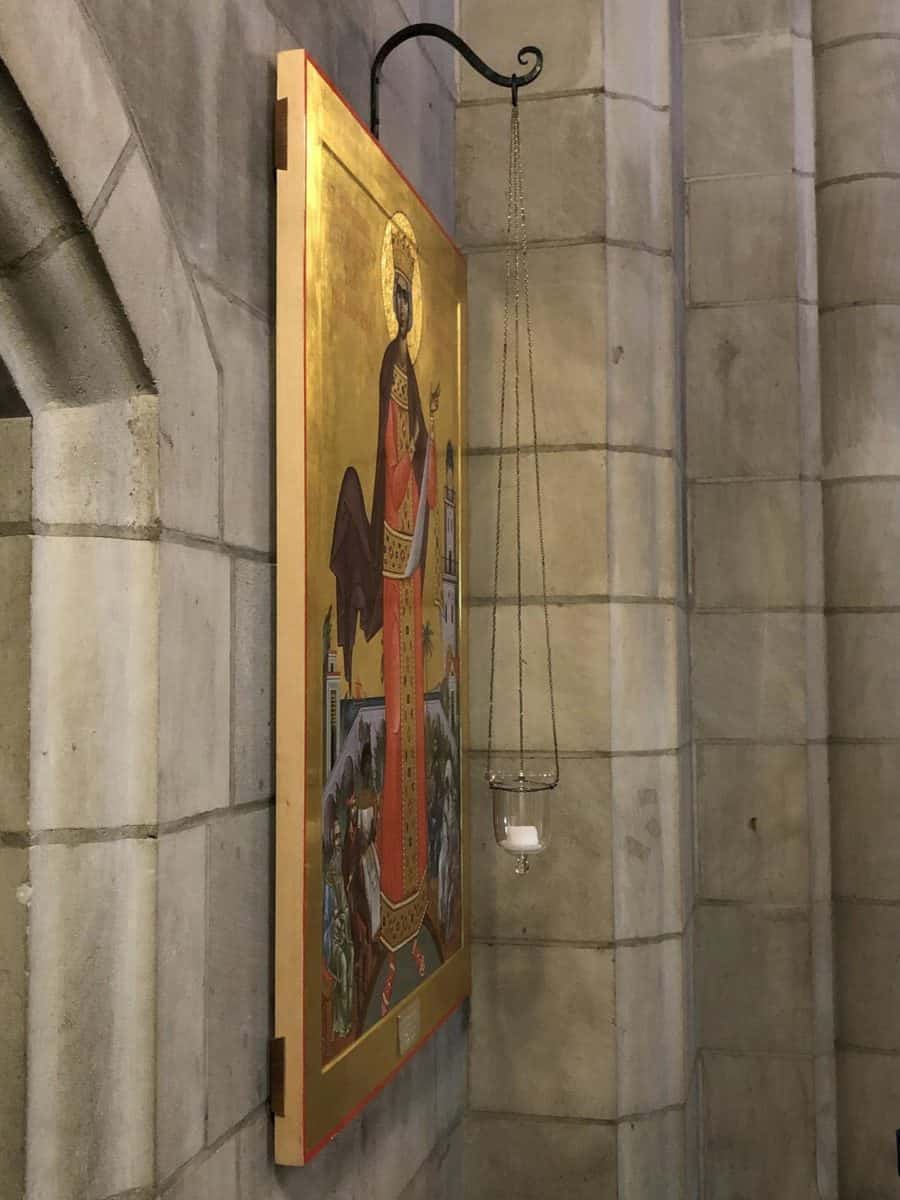
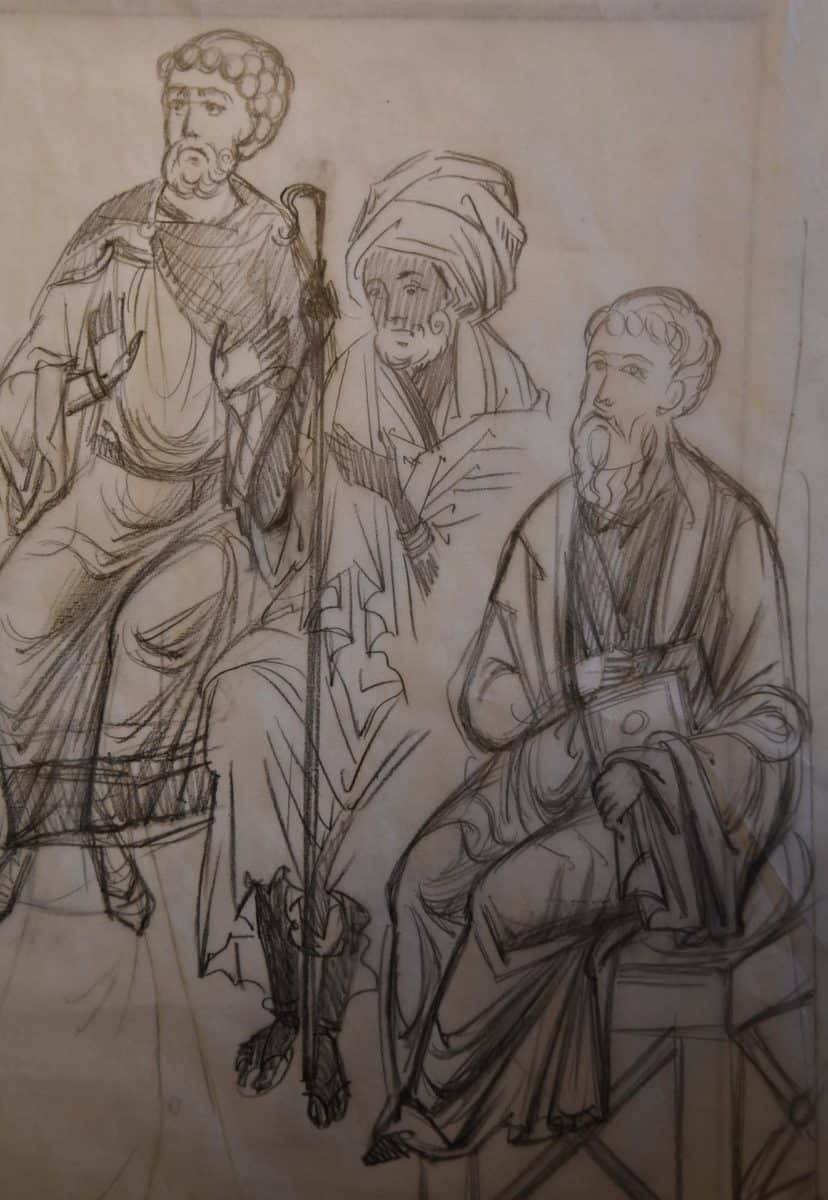
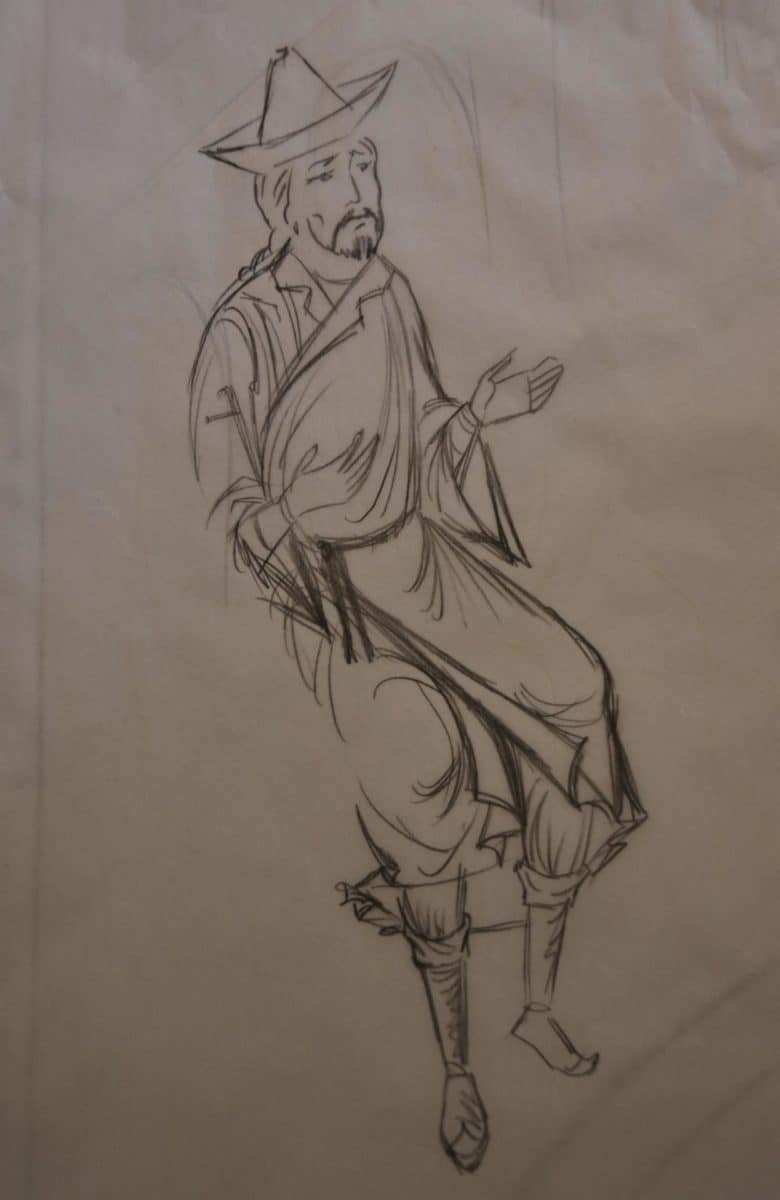
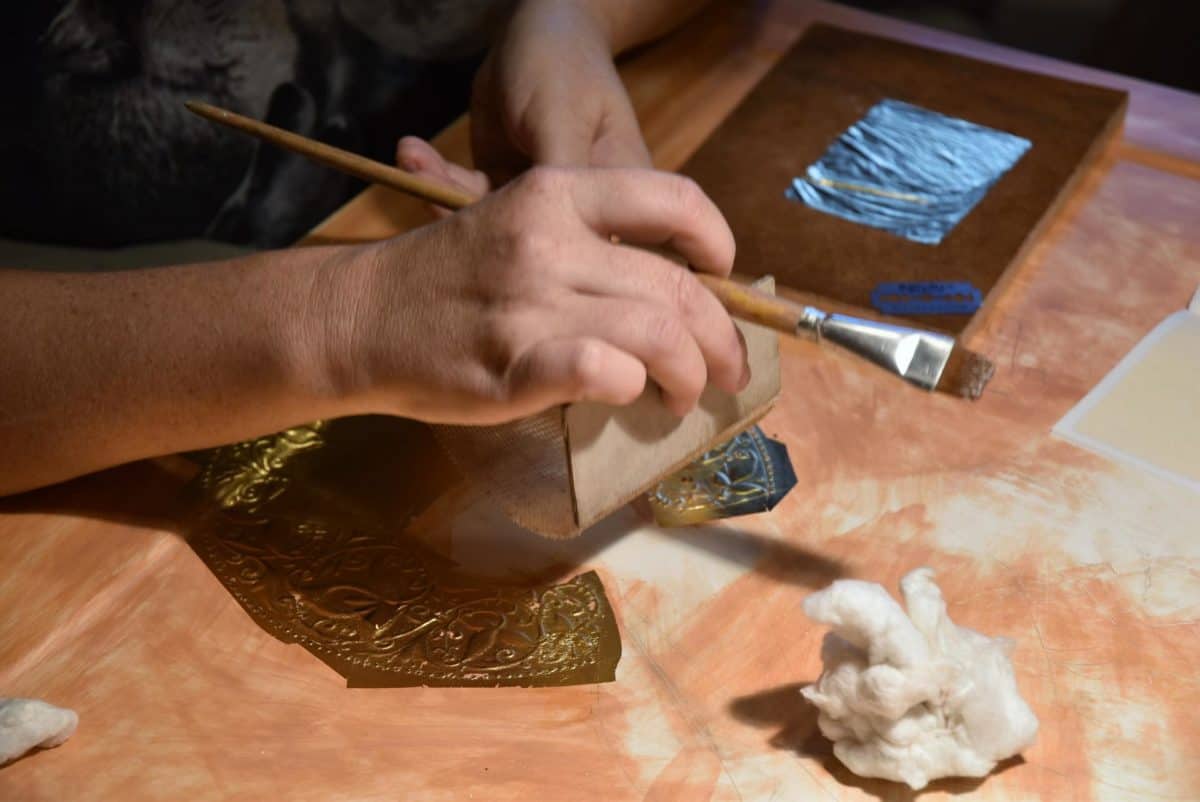
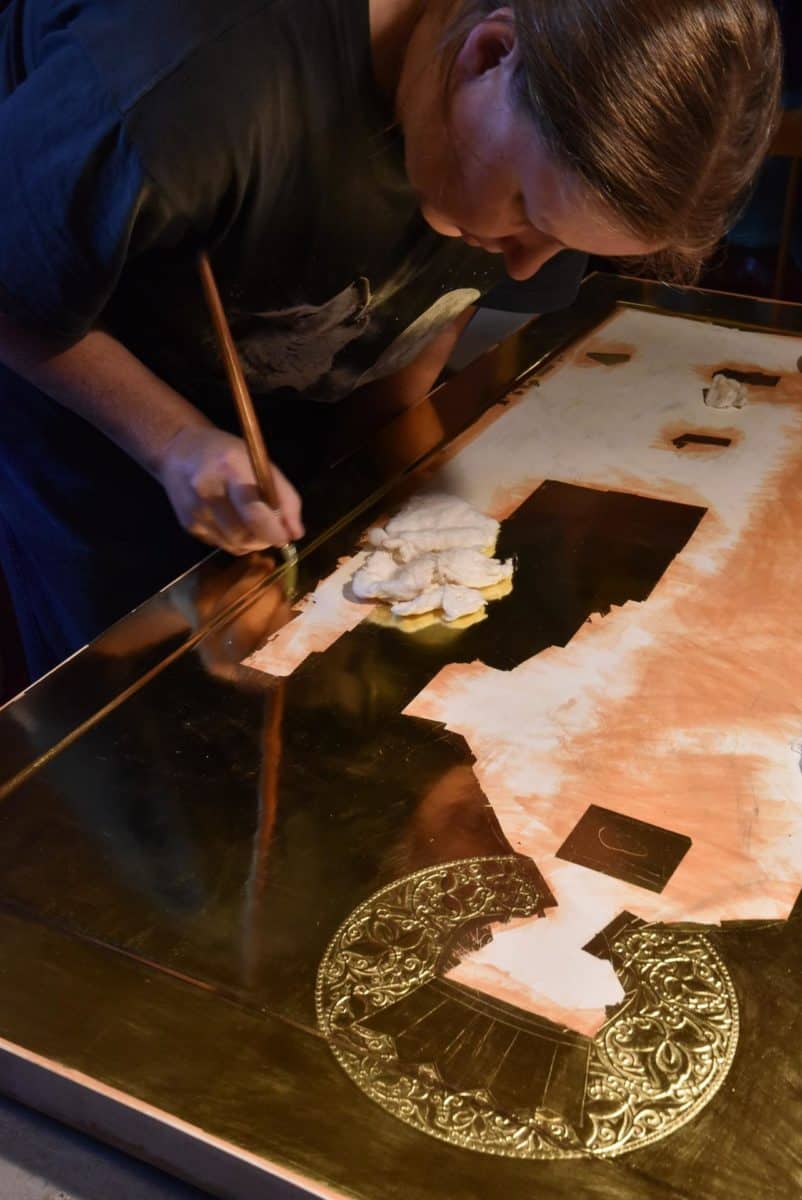
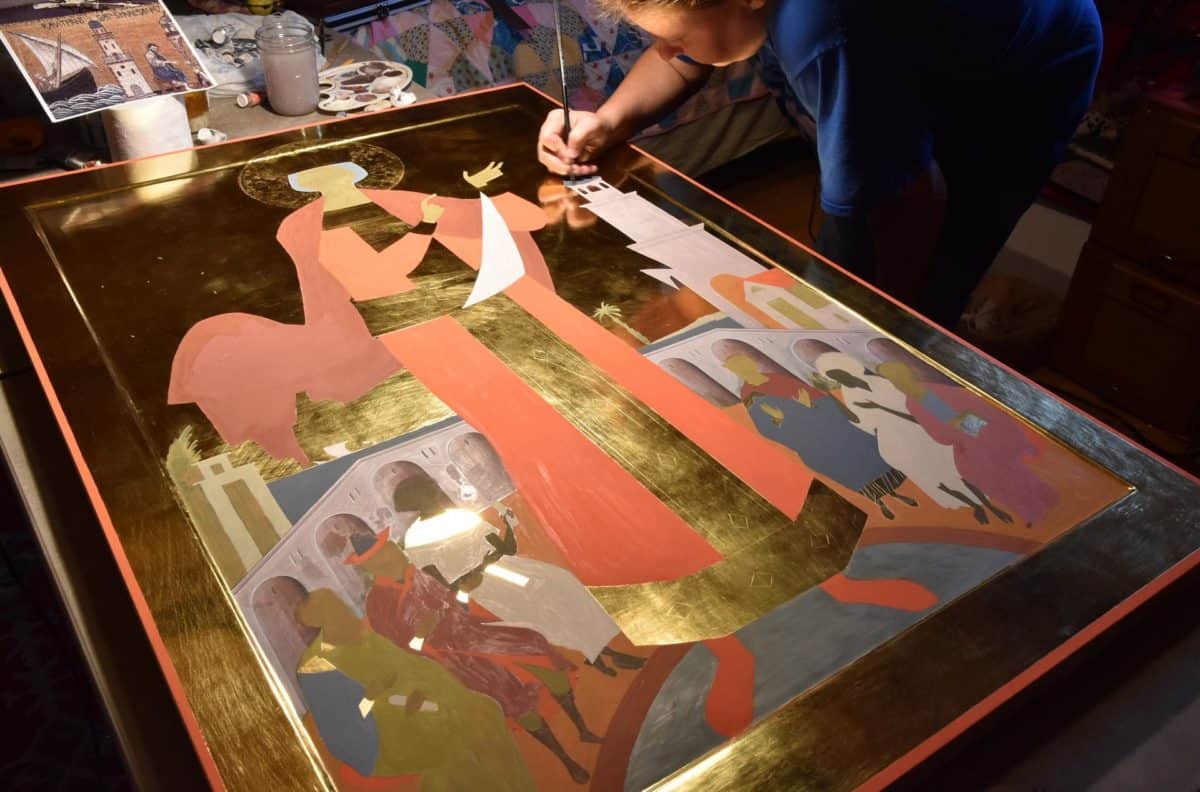
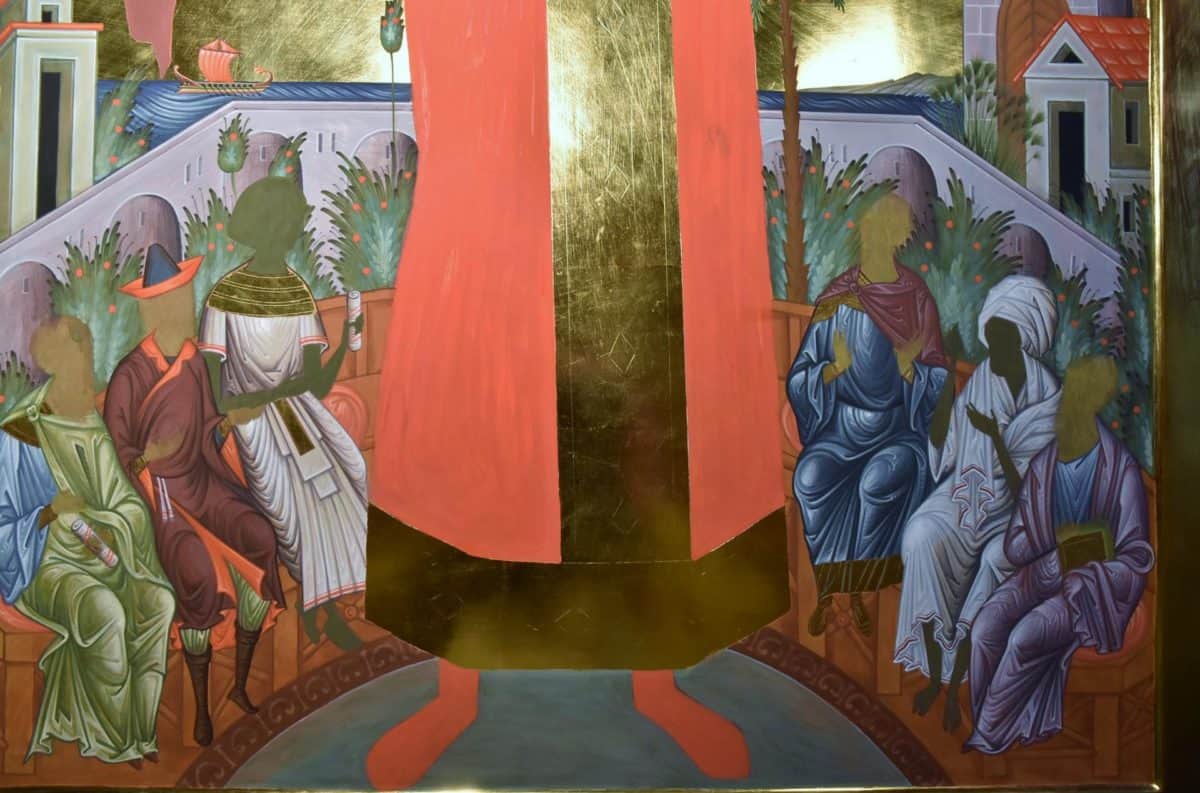
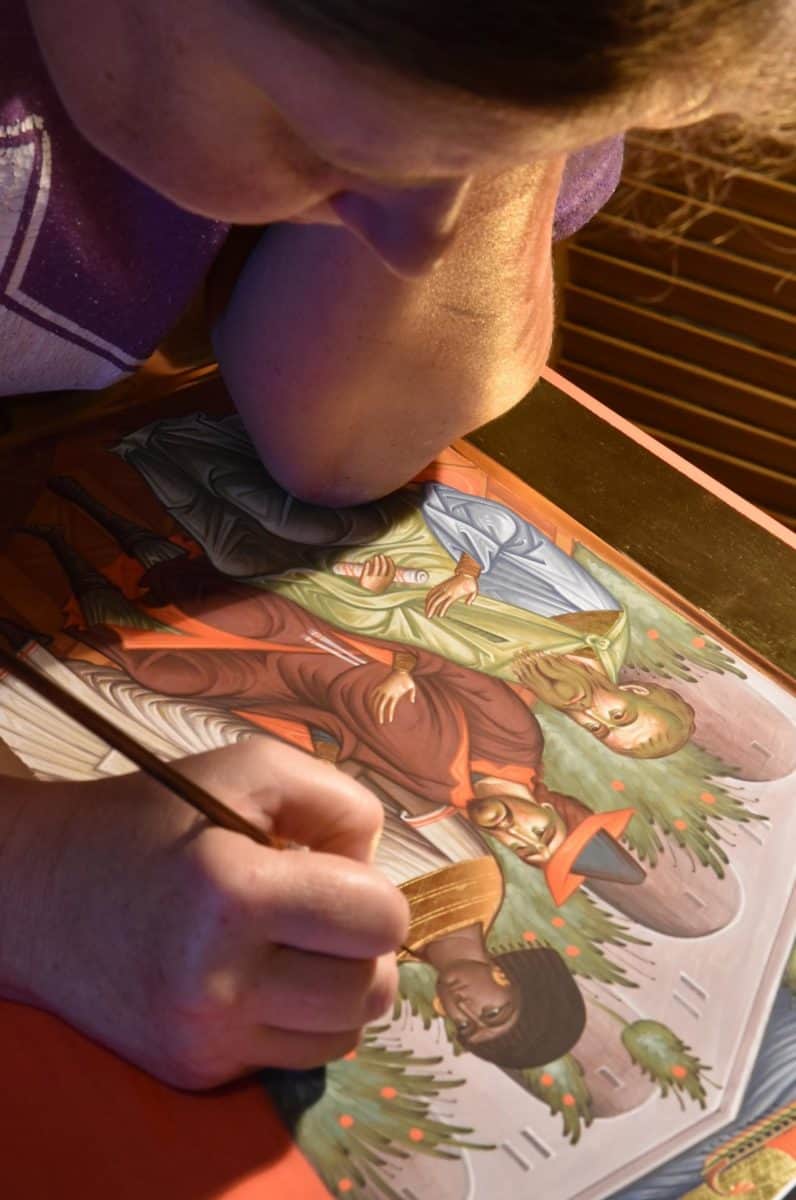
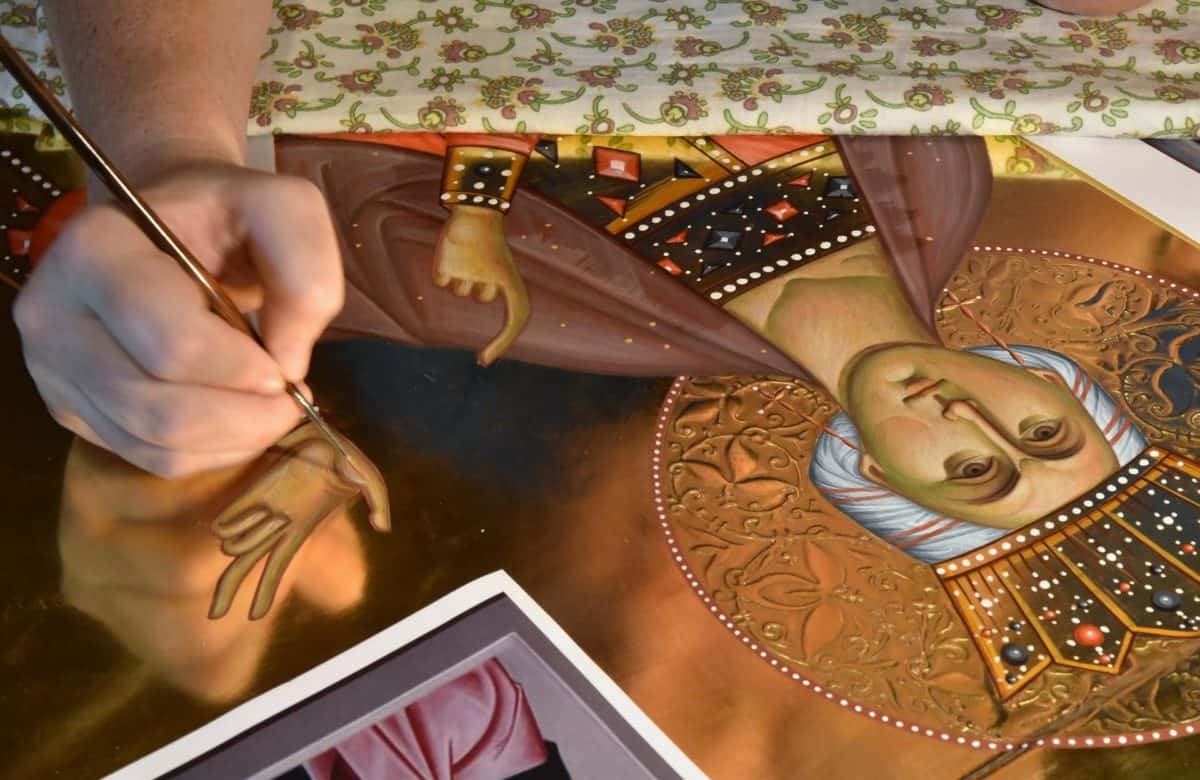
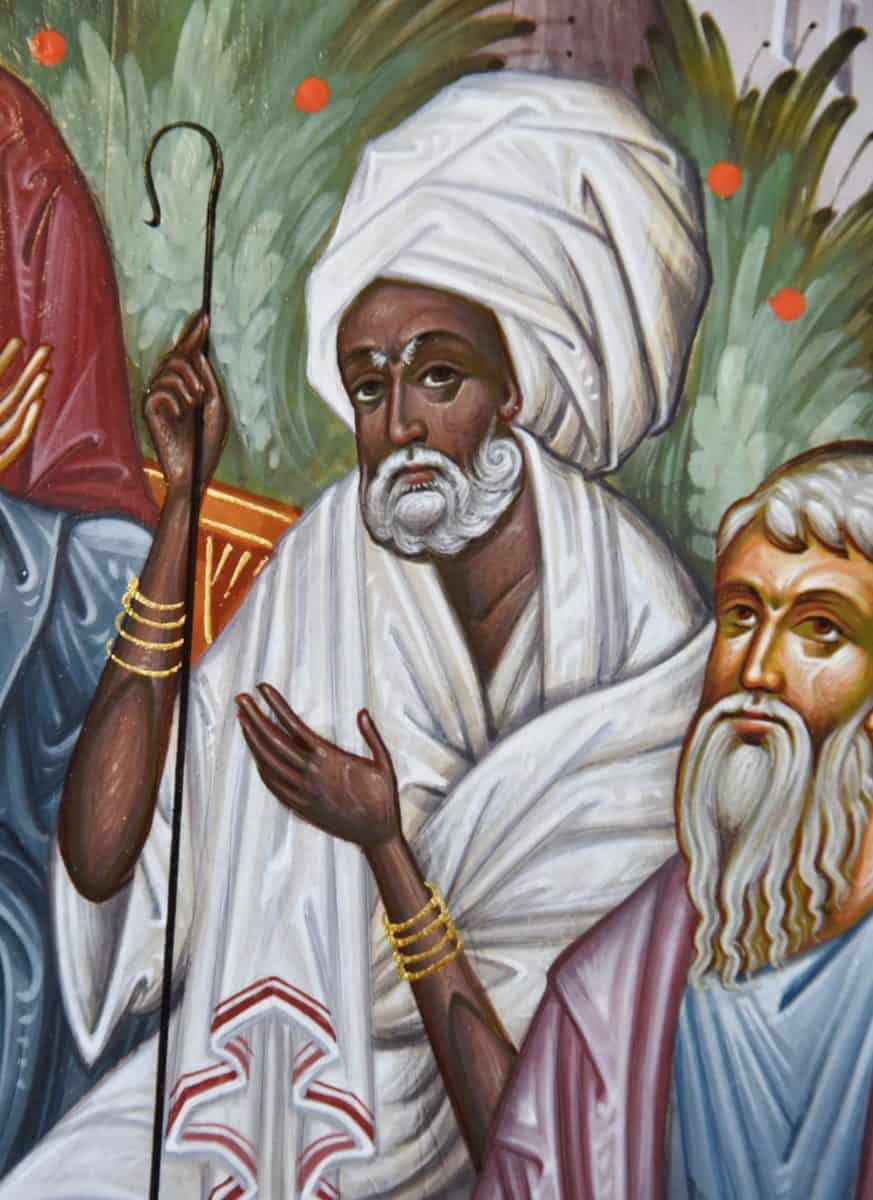
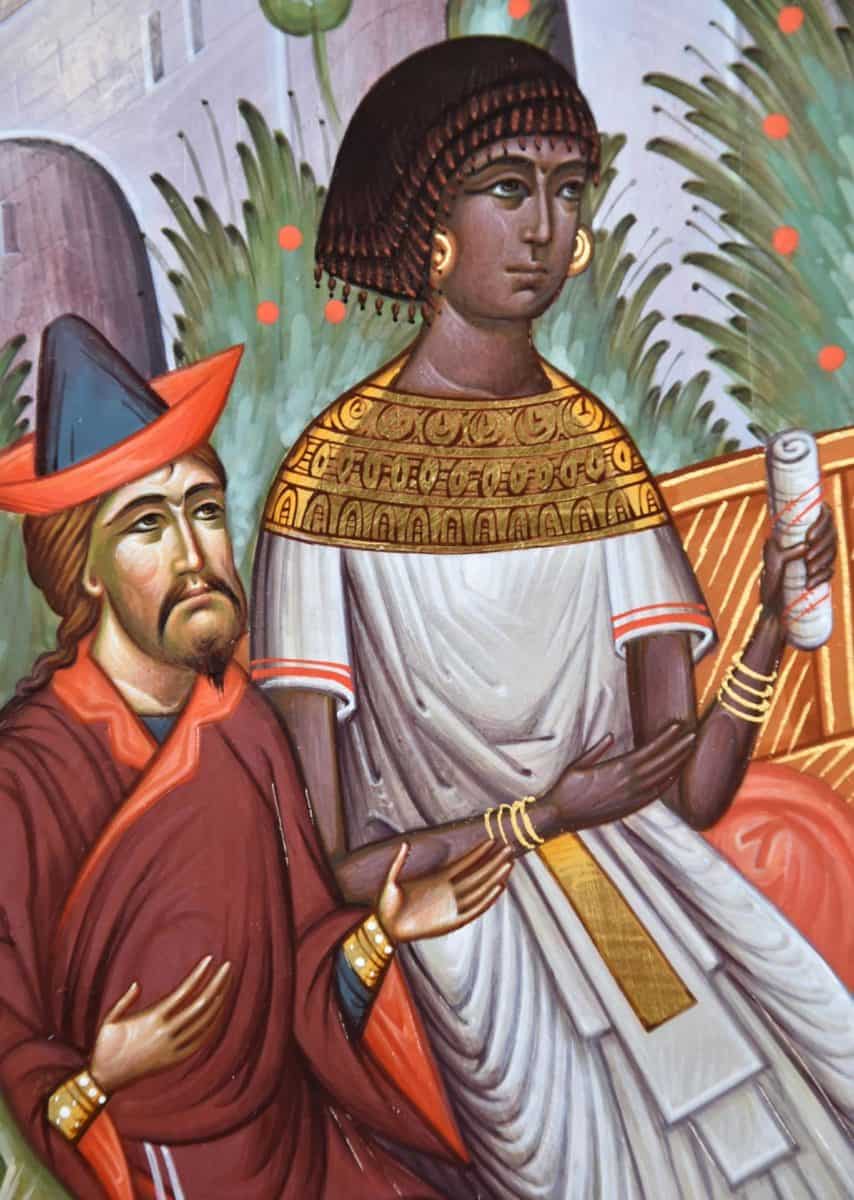
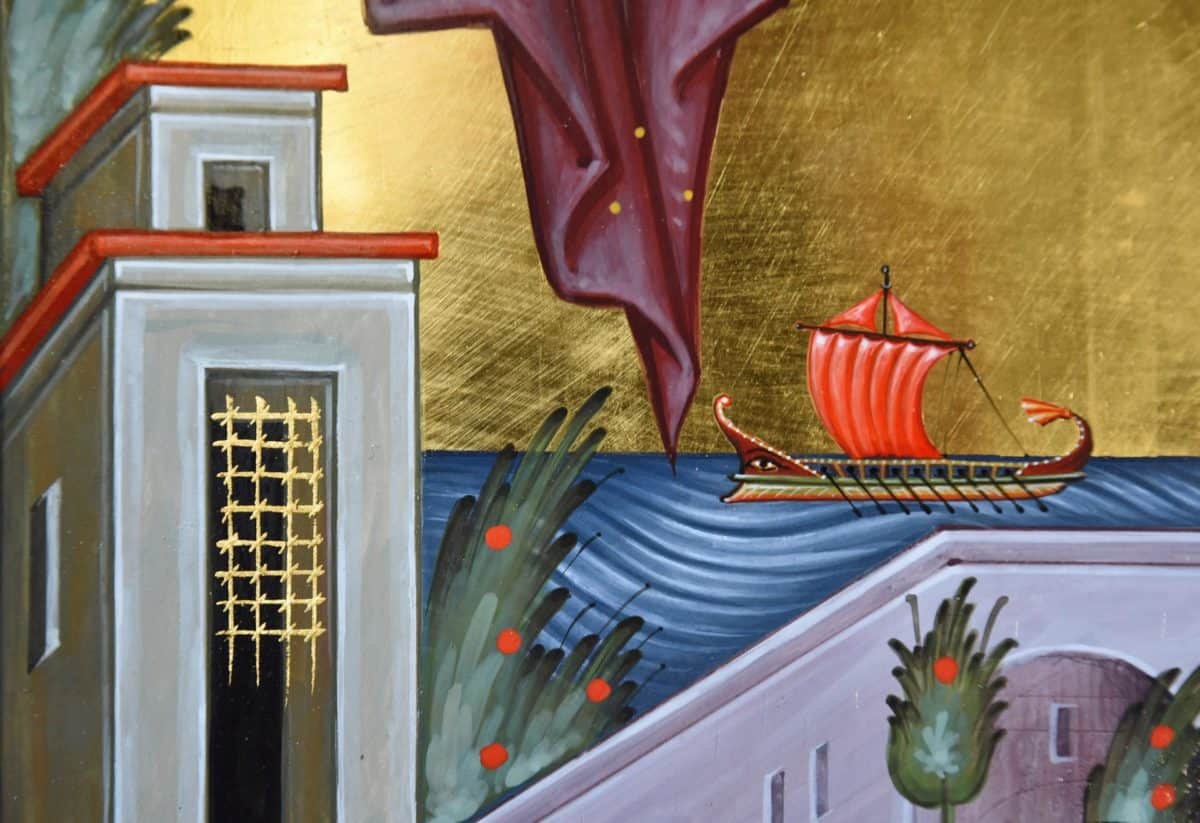
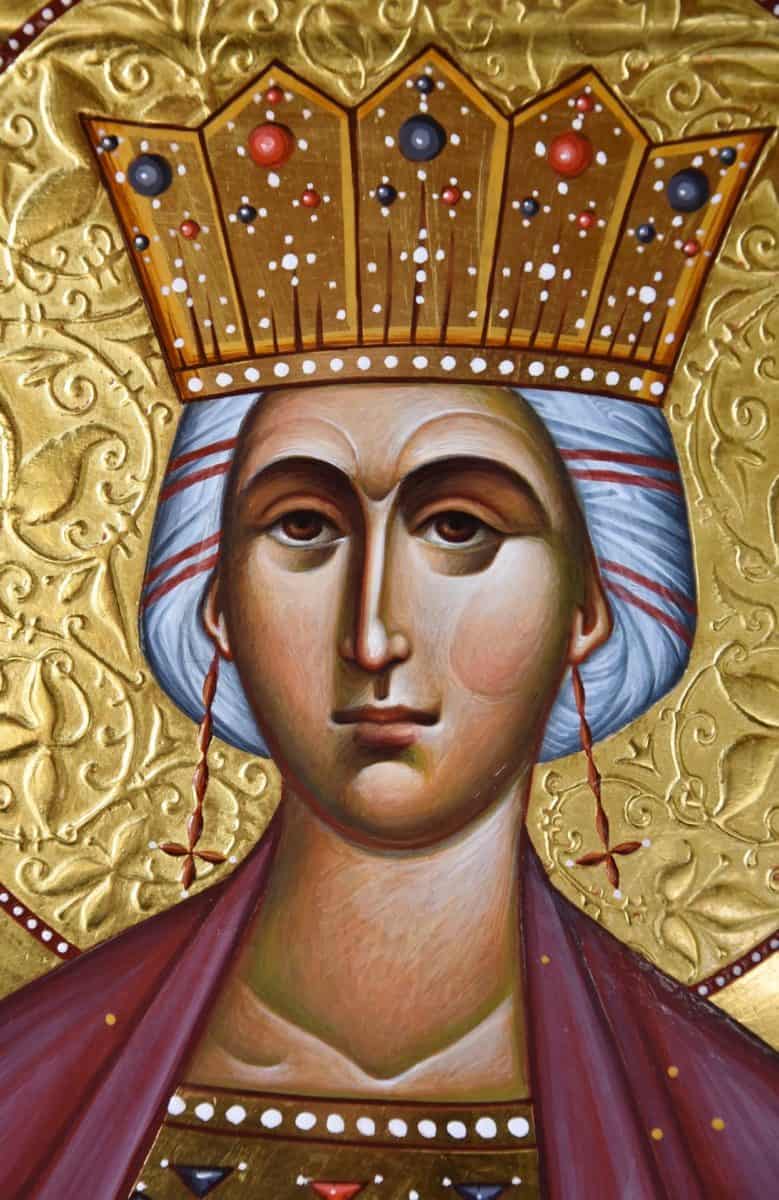
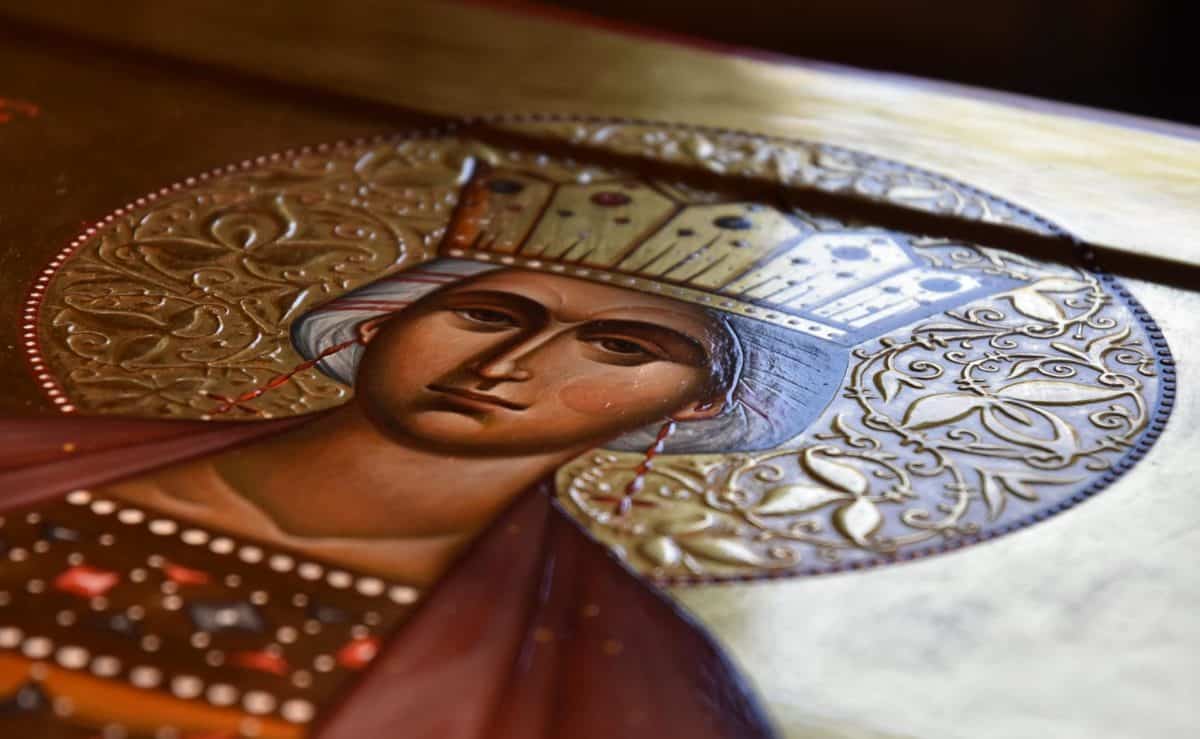
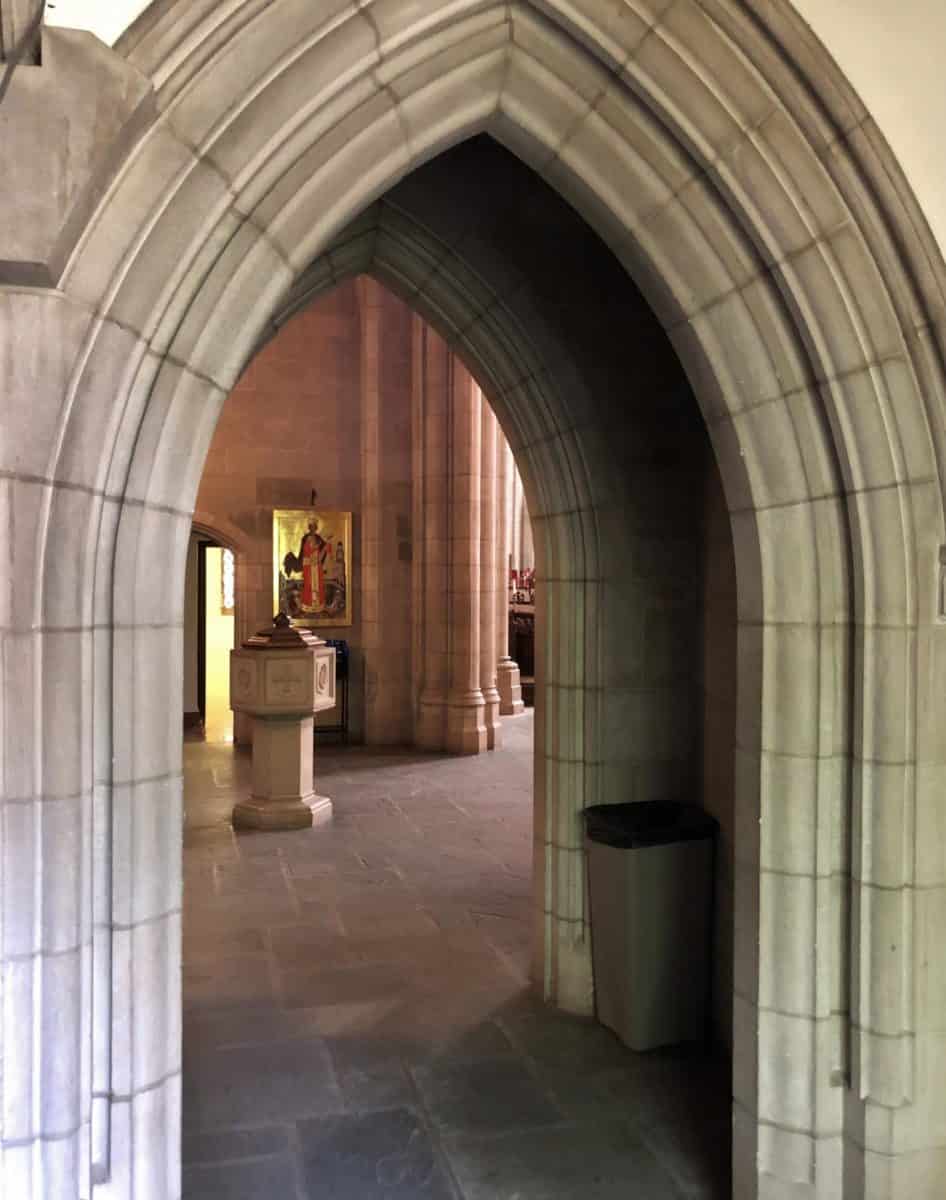
Stunning, and an intriguing process.
Absolutely stunning work as usual! I really enjoyed how you included all the aspects that the college required while still maintaining the necessary hagiography. Natalia and yourself are both truly talented. Is the font you designed available anywhere?
As a computer font? No. Maybe someone with that skill would like to make it so. I always draw inscription lettering by hand.
Are all the letters available as a hand-drawn alphabet if another iconographer wishes to adapt something similar. For example, how would you write the J, Q, or Y?
I haven’t drawn out an entire alphabet, but you can see some additional letters in the inscriptions Natasha painted on these two icons, which we worked on at the same time as St. Katherine:
https://www.dropbox.com/s/dggxf6qqruvpx20/NWB_0285.JPG?dl=0
https://www.dropbox.com/s/if9vudmat9bf13x/NWB_0292.JPG?dl=0
Masterful job, Andrew and Natalia! I hope and pray that some of the students revere this icon and turn to Orthodoxy!
Beautiful work. Thank you for sharing.
This is wonderful information and a stunning icon of St. Katherine. Beautifully conceived as to detail. Thanks so much for sharing this. Glory to God in His Saints!
I thought it was both masterful iconography and appropriate for the purpose and setting.
Wonderfully vibrant. Deeply reverential.
It will draw and edify many, to be sure.
Profoundly beautiful icon and backstory. To donate, I must use a check from my Discretionary Fund…Address???
A magnificent hagiography of a beautiful saint. The work and detail is impeccable. Glory to God for your talents. I am sure that the architect would have approved of having such a beautiful icon placed in his Gothic design.
I pray that we will be able to have prints made for purchase.
Too much gold for my taste . I think it tends to dominate an otherwise really lovely ikon.
Thanks for sharing context and process.
Beautiful. Wonderful job incorporating all of the requests of the clients as well. Question: is this painted in egg tempera or acrylic? The photos make it look like it was painted in acrylic.
Natasha painted it using Master Class brand PVA tempera, which is made in St. Petersburg. This is chemically similar to acrylic paint, but formulated to behave more like egg tempera.
Thank you for this article explaining your composition process. The research into appropriate figures and the background make this such a clear image of St. Katherine. It is truly a venerable icon. Congratulations to both of you.
Thank you for sharing the story of how both you and the iconographer worked together to create an educational and compelling icon.
Some features caught my attention. For instance, the size of St. Katherine compared to the other aspects in the icon. You mentioned that as is a devotional icon, you wanted St. Katherine to be larger than the other figures and structures. You fulfilled your goal in that, also I like how her size interacts with the lighthouse. Both the ancient and current lighthouses stand as symbols of the progress, power, and intellectual glory of the ancient city of Alexandria, yet those substantial accomplishments pale in comparison to the life-giving message taught by St. Katherine. Even the small detail of the flame, ie. knowledge or truth, shining in the small window in the lighthouse being the same color as her robe makes the same comparative statement. Perhaps I am off-base in my reaction to those details, but for me that comparison deepens St. Katherine’s message to whomever encounters the icon.
I am also especially taken with the facial and hand expressions of the Ethiopian philosopher. He is looking at the person encountering the event in the icon, and his eyes, facial expression, and hand are inviting us to listen to St. Katherine’s teaching and to encounter God, even if it means, as I’m sure those martyred philosophers understood even before the debate, that we may lose our life. This is a deeply powerful invitation.
As a previous commenter noted, I too hope that it will soon be possible to obtain a copy of this icon. I am going to forward this article to a very dear friend of mine from Ethiopia who, with her husband, is studying in the United States. Her life, like the expression and hand of the Ethiopian in the icon, is an invitation to know and love God. May God bless you and Natalia Aglitskaya in your lives and your work.